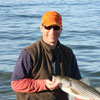Learn to Fish on Land
By Tom Keer
Apr 08, 2016
Learning to fish takes practice, so if you can't get on the water, work out on land.
The bite was hot, there were fish blitzing the surface, and I held the bait casting rig in my 10 year-old hands. I'd never seen anything like this before, and I ripped off a cast as hard as I could. The only issue was that I didn't thumb the spool, and I had a massive bird's nest of line. My late-father was not happy at all, and by the time he cleared my mess the fish were gone. We caught very few that day.
After that frustrating experience I practiced on dry land. Here's how:
- Yard Work Accuracy. Set up a series of different targets throughout your yard. They could be a metal pie plate, a paper plate, or a bandana. Stage them in different distances, near obstacles such as trees, bushes or fences. Add a sinker to your line or take the hooks off your lure and practice away. Repetitions are better, so every day for half-an-hour is preferable to once a week for three hours.
- Use different rod/reel combinations. Rod length and action vary significantly, so practice with the rod outfits that you'll use when you hit the water. Get used to the way the rod loads and how it flexes. It's a good time to use spin, baitcasting or fly rods; learning different methods increases each anglers' experience.
- Fly rod yard work. Learning to fly cast isn't hard, but it does require the repetition that comes from practice, coordination and timing. Begin with a simple false cast, and work on your rod movement and timing. Then add the shooting and retrieving of line, and then work on specific casts. A roll cast is great if you have trees or banks behind you, and a reach cast is helpful to make a drag free float. Hoola hoops make excellent targets, and tie a brightly colored piece of yarn to your leader. Remember to practice different ways to retrieve your line: use both a strip retrieve and a hand-twist.
- Knots and rigging. Tie knots and rigs until you know them by heart. It helps to learn them before you hit the water. If you have a hard time following diagrams, check out an online video; that way when you're on the water you'll twist them up in no time flat.
Learning how to fish doesn't have to be in an actual fishing situation. The more practice time a new angler logs the better skills he'll have when he hits the water. You'll get some funny comments from your neighbors, so check how to cook your catch and drop off a fish for their dinner!









